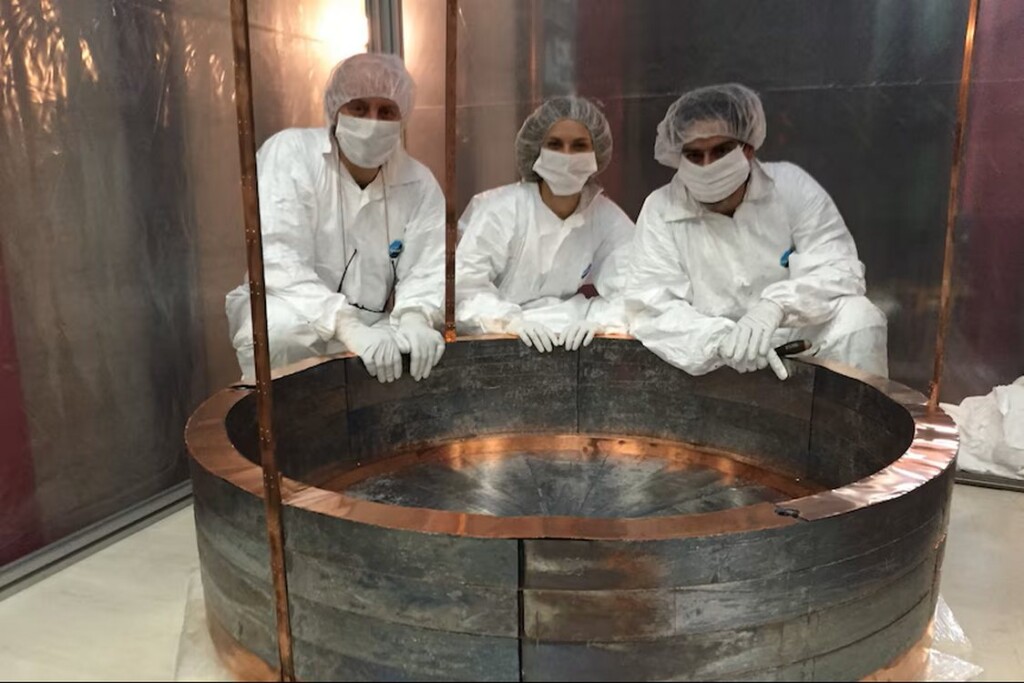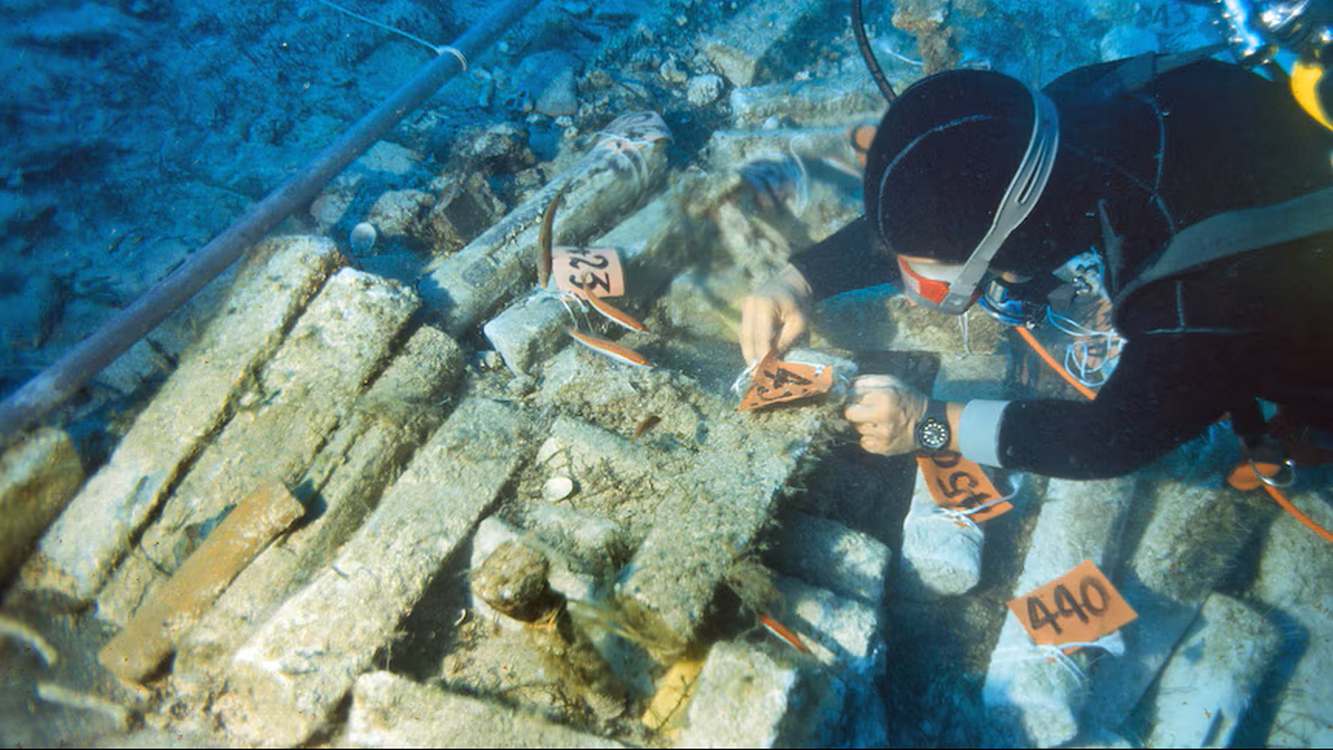 Hundreds of lead bricks were found in a ship that sunk between 50 and 80 BCE – credit, CUORE Collaboration and LNGS/INFN
Hundreds of lead bricks were found in a ship that sunk between 50 and 80 BCE – credit, CUORE Collaboration and LNGS/INFN
What do dark matter, the Roman Empire, and a toxic heavy metal have in common?
The answer is Mr. Ettore Fiorini who helped excavate a 2,000-year-old shipwreck whose cargo of Roman lead bars could, he believed, help him unravel the secrets of the universe.
If the second sentence made no more sense than the first, let’s do some storytelling.
Sometime between 50 and 80 BCE, merchants or military engineers from Rome were transporting a cargo around the island of Sardinia that included hundreds of pounds of lead ingots from Spain meant for building ammunition or aqueducts.
The sea was angry that day, and sent the cargo down to the crushing black oblivion of Davy Jones’ Locker. In 1988, the ship was discovered, and the maritime archaeologists working on it got a message from a strange address: Istituto Nazionale di Fisica Nucleare, Italy’s National Institute of Nuclear Physics (INFN).
The sender was Dr. Fiorini, who wasn’t interested in the historical value of the shipwreck, but wanted the lead to build a radiation shield for a particle detector deep under a mountain.
Lead is used to isolate chambers from radioactivity, which is why we wear lead vests when taking x-rays. However, lead itself also contains trace amounts of a radioactive isotope lead-210, which can interfere with any observations.
The experiments need to be absolutely free of any outside radioactive interference—which can come from anything—to ensure that the scientists can say whatever they see in their experiments is genuine and not noise. The cool thing about the Roman lead is that, having sat underwater for 2,000 years, the radioactivity had completely decayed, making the ingots perfect for isolating the chamber where the experiment would take place.
What was Fiorini looking for in his experiments? Nothing less than the detection of dark matter at work on Earth.
 The CUORE particle detector – credit, CUORE Collaboration and LNGS/INFN
The CUORE particle detector – credit, CUORE Collaboration and LNGS/INFN
Between past and future
Some archaeologists have brought up ethical dilemmas with destroying ancient artifacts to conduct modern experiments.
The lead in the Sardinian shipwreck, for example, was melted down to create a shield for Fiorini’s particle detection program. Each one of the ancient lead ingots had a stamp on it in Latin, carrying information about its origin and brand.
Dr. Paolo Gorla, an INFN physicist, told ABC News Australia that the historic value wasn’t lost on Fiorini and his team, who struck a bargain with archaeologists that with money and backing from the INFN, they would help recover the shipwreck—but they would get to keep the lead.
The archaeologists eventually agreed on the condition that each ingot be documented thoroughly.
“Something amazing is that the companies that extracted the lead from the mine stamped [their] brand on top of the bricks,” said Dr. Gorla, adding that part of the deal was an examination by the physicists of each ingot at the molecular level to look for contaminants that might hint at the object’s place of origin.
“It was like an ID card … it helped the cultural heritage officials reconstruct from which mine in Spain this lead was extracted.”
 Scientists posing with part of the ancient lead shield for CUORE – credit, CUORE Collaboration and LNGS/INFN
Scientists posing with part of the ancient lead shield for CUORE – credit, CUORE Collaboration and LNGS/INFN
Gorla called it a mutual exchange between lovers of history; only that the archaeologists’ love affair was with the history of Rome, and his affair was with the history of the universe.
ITALIAN SCIENTISTS AT WORK: Graphene Dream Becomes a Reality as Miracle Material Enters Production for Better Chips, Batteries
The INFN received their long-awaited lead treasure in 2010, and in 2017, armed with a new shield made of melted Roman lead, the CUORE detector (Cryogenic Underground Observatory for Rare Events) began its work under Gran Sasso mountain.
Dr. Fiorini passed away in 2023, and an upgrade to his life’s final project will soon arrive that should allow CUORE to identify the particles it has detected, none of which, as of yet, has turned out to be dark matter.
CUORE is kept at near absolute zero temperatures, is shielded from cosmic radiation from the Sun by the mountain, and shielded from radiation in the lab by the Roman lead. Here, any elementary particle leftover, if touching any other particle, would raise the temperature in the observation chamber ever so slightly, allowing for quick identification of particle collisions.
MORE SCIENCE COLLABORATIONS: Pollution Efforts in Lake Tahoe Have Cut Sediment and Algae Run-off to Preserve the Water’s Iconic Clarity
Dark matter is thought to make up 85% of all the matter in the universe. It doesn’t interact with light, but it does feel the effects of gravity. Experiments like Fiorini’s may be key to making a detection of this strange substance on Earth, and his idea that Roman lead was a key component in any successful detection, was clearly a good one.
“We can easily tell that without the quality of the shield, we would not have been able to measure at the level we’re measuring now,” Dr. Gorla says.
SHARE This Unorthodox Scientific Collaboration To Study Dark Matter…

